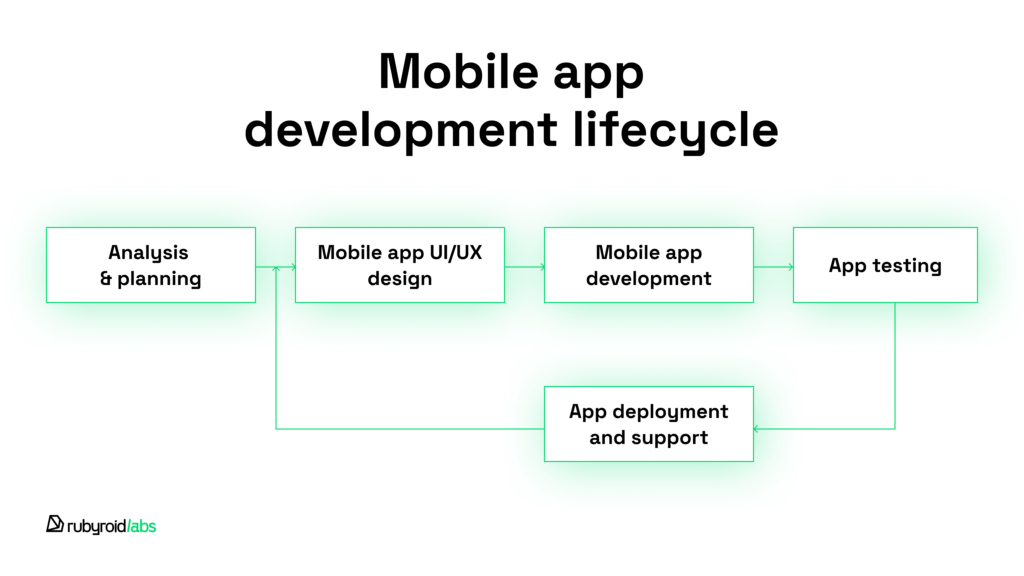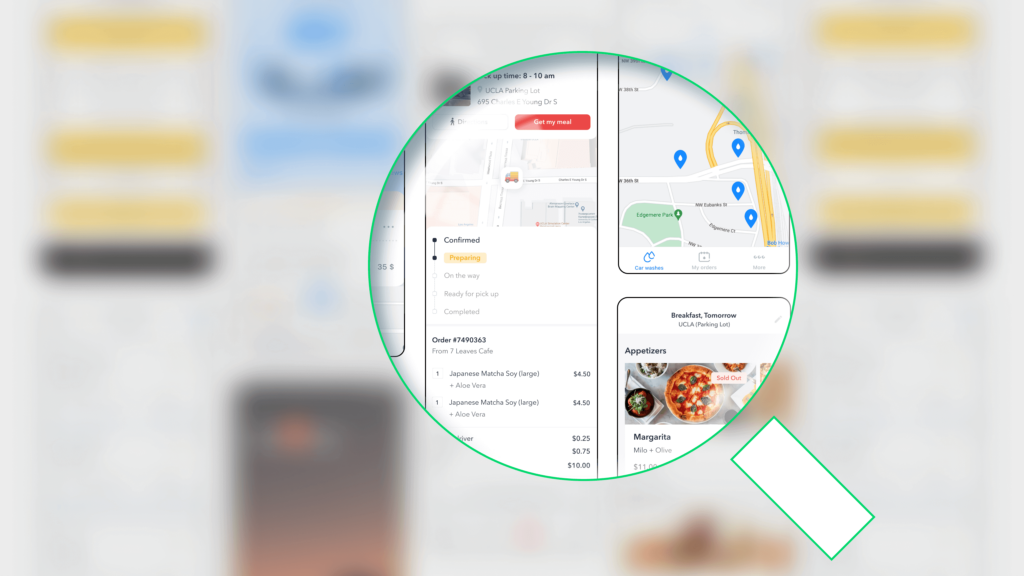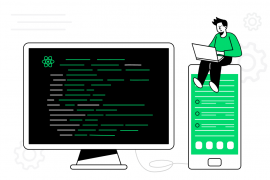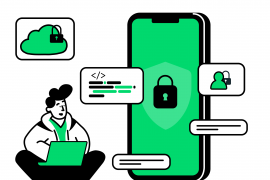Mobile users have crossed an impressive number. In 2025, it’s supposed to reach 7.49 billion users, representing over 90% global penetration in a world population of approximately 8.1 billion people.
This interesting fact confirms that a mobile app is a powerful tool for businesses. It can help to attract users, boost brand visibility, support marketing strategies, and improve customer retention.
The decision to create your own app for your business is a significant step. However, it involves much more than simply hiring a development company. You will need to invest your time to get prepared for the process. That’s where our step-by-step strategy will help you.
Contents
- Mobile App Development Process: 5 Key Phases of Product Creation
- 10-Step Guide: How to Make a Mobile App from Idea to Launch
- Conclusion
- How Much Does It Cost to Build an App?
- How Do App Developers Charge for Their Services?
- How Long Does It Take to Build an App?
- iOS App Development vs. Android App Development: What’s the Difference?
Since 2013, we at Rubyroid Labs have been successfully creating mobile apps for startups and companies of all sizes, earning a five-star rating on Clutch.co as a highly skilled tech team that excels in communication.
We have summed up all our experience in mobile app development and made a 10-step guide on how to develop an app. Go on reading to stay tuned on what phases a mobile app development process includes and what to prepare for it in 10 steps.
Mobile App Development Process: 5 Key Phases of Product Creation
To build a mobile app, finding someone with strong coding skills and experience is not enough. You need a team that values transparency, collaboration, and truly listens to its partners.
So, before entrusting the development of your future product to a company, you need to understand how the process of product creation is organized.
Building an application is a complex, multi-stage process consisting of several phases that may slightly change in each particular case.

1. Analysis & Planning
This phase, also known as the discovery phase, is the basis of the entire development process.
It normally starts with close collaboration with a business analyst (BA), who can translate your initial idea into a well-defined, functional project and ensure that all your requirements align with the real vision for the app.
With the help of the business analyst, you’ll get your own BA artifacts. These are the documented blueprints of the project development process that include:
- Vision & Scope: a detailed description of the app’s concept, your business goals and needs, the app’s core features, target audience, priorities, and deadlines.
- Software requirements: how the app will interact with the user, the need for MVP (minimum viable product) development, business requirements, tech stack, and third-party integrations.
- UX/UI requirements: the description of the project structure and functions that should be on each page.
- Estimates and priorities: time, costs, and a team structure for the project.
The discovery phase differs in every company. At Rubyroid Labs, we provide the discovery phase and BA artifacts as a part of the entire product development cycle or as a separate service in case a client wants to work on the idea and develop the app later.

2. Mobile App UI/UX Design
At this phase, UI/UX designers create the visual and functional design of your application. This includes wireframes, style guidelines, user flow architecture, and mockups. It will help you understand what the app will look like.
At our company, we provide full UI/UX design services that include comprehensive market and industry-specific research, modern design trends, your business requirements and goals, and user needs. All of this is reflected in dynamic prototypes that help visualize how users will interact with your future app.
3. Mobile App Development
This is the starting point of the coding process. If you want to be actively involved in the building process, select a company with an agile approach.
Agile breaks the process into sprints or iterations, which generally run 1-4 weeks. Each sprint includes weekly meetings where a client takes part in progress discussions and provides feedback on the current work. During each sprint, developers complete certain features or user stories and provide a demo to confirm whether the client’s goals are met and to get feedback.
4. App Testing
QA tests are an instrument to ensure the application’s stability, security, and performance.
At each level of development, QA engineers thoroughly test the app, identifying and resolving any bugs or issues. Comprehensive testing covers a wide range of areas, including user experience, functionality, security, and cross-platform compatibility.
Testing is critical because it helps deliver a high-quality product with fewer errors, reducing the need for extensive code reviews.
5. App Deployment and Support
The last stage of development normally includes further support and maintenance of the product after it is placed on an app store.
Depending on your agreements with a company, you can get the following services:
- Regular app updates
- Bug fixes
- Feature enhancements
- Security improvements
It is always you who defines the needs for your application and discusses them with your development company.
Each of these development phases is critical for a successful mobile app that meets users’ expectations and keeps them engaged and satisfied. A can-do attitude and willingness to listen allow our programmers to tackle even the most complex challenges.
Next, we will provide a step-by-step guide on how to refine your idea before presenting it to a development company.
10-Step Guide: How to Make a Mobile App from Idea to Launch
If you want to create an application that will win users’ hearts, you need to share your ideas and maintain an open dialogue with the development team.
Following these 10 steps will help you prepare for an enjoyable mobile application development process and make it a success.
1. Define Your App Idea & Goals
Every project starts with a concept and the desire to provide the greatest product for people. Define your own idea and write down anything you would like the app to perform. This will help structure your thoughts and allow for more creativity and planning.
Make sure your mobile app idea focuses on specific customer needs and solves their major challenges.
For example, consider an app designed for urban gardeners. The app helps them track planting seasons, provides care reminders for various plants, and offers a platform to purchase seeds and gardening tools. By solving the problem of remembering plant care schedules and finding the right supplies, the app makes gardening more accessible and enjoyable for city dwellers.
Moving ahead, determine the business objectives you hope to achieve by developing the mobile app. You may set them for both end users and your business. Try to make them realistic and measurable.
Present your idea and goals to your development team to organize the development process more effectively and efficiently.
2. Perform Competitive Research
At this stage, you have to make sure that your idea is in demand and that people will download your mobile app. To make your app stand out, you need to conduct competitive research in the market.
- Examine the existing products on the Android and iOS platforms.
- Analyze the competitors in your niche and note the strengths and weaknesses of their apps.
- Create a focus group and conduct interviews and surveys. The more information you gather from your potential users, the better you’ll understand and work out every detail and feature of your mobile app.

3. Identify Key Features
Don’t know yet what functionality your mobile app should have? Then use the data about your competitors from the previous point. It will help you decide what features are best for your product.
Users will always choose an application that is intuitive and simple to use.
You might want to implement as many “trendy” features as possible, but think twice. Not all mobile apps need AI integration or voice control. Unnecessary features can eat up your budget and time for development. Here are examples of popular but potentially unnecessary features in mobile apps:
- AI Integration: While useful for marketing, finance, or e-commerce, not all apps need artificial intelligence assistance while using a mobile application. For example, apps that provide static content: e-book readers, recipe collections, or offline dictionaries.
- Push Notifications: Overuse of push notifications can annoy users, especially if the notifications are not highly relevant to the app.
- Custom Avatars and Emojis: While fun and engaging, these features are often useless unless the app’s core function revolves around social interaction or communication.
- Augmented Reality (AR): AR can be entertaining but is frequently unnecessary and can complicate the user experience.
- In-App Games: These are sometimes included as an engagement tool; however, they are often superfluous and consume a lot of development resources.
- Complicated User Customizations: Wide customization options for app layouts, colors, and controls may overwhelm users instead of improving their experience.
- GPS Capabilities: GPS is a powerful feature for location-based services but is useless for apps that don’t utilize geographical data. It can also reduce battery life and raise privacy concerns among users.
- Voice Control: While voice control is trendy, it is not necessary for many types of apps, particularly those that require quick, simple interactions better suited for touch controls.
Implement only essential functionality that aligns with the app’s goals and user needs. Otherwise, you risk wasting your money and losing user engagement.
4. Create Wireframes and Mockups
The next step is the visual appearance of your mobile app. You can either provide your development team with a wireframe drawn on paper or work with a UI/UX designer during the discovery stage, before the start of your product creation.

In any case, you will need to create mockups. These clickable or non-clickable prototypes of the application are important for all participants in the mobile application creation process, including:
- You, to better express your expectations to the developers.
- The development team, to grasp the app’s intended appearance and functionality.
- Your stakeholders and investors to visualize the future product before the development begins.
At Rubyroid Labs, our UI/UX designer collaborates closely with the client, working out all their requirements and user needs. Based on this information, the specialist creates user stories and use cases, then builds a prototype of the app with an intuitive and user-friendly interface.
5. Choose Technologies and Tools for Your Mobile App Development
Technologies, platforms, and development tools form the engine of the product. So, to make the application more performant at present and scalable in the future, you need to make well-informed choices.
Here are the key criteria to consider when selecting the appropriate tech stack, which you can discuss in detail with your development team:
Mobile platform
Define which mobile platform is better for you and what type of mobile app you want. You can develop a native app on Android or iOS, a cross-platform or hybrid application, or even a PWA (progressive web app).
Programming languages and frameworks
Different frameworks and platforms use their own compatible programming languages. Depending on the type of platform you have chosen, your app can be built in the following languages:
Native mobile apps:
- Swift or Objective-C for the iOS platform
- Kotlin or Java for the Android platform
Hybrid and cross-platform apps:
- JavaScript, TypeScript, HTML, and CSS for development with the React Native framework
- C# for applications in the Xamarin framework
Technologies
Check out the technologies you want to implement in your mobile app and discuss them with your development team during the discovery phase.
The choice of technologies typically depends on the following factors:
- Mobile platform: determine if your target audience mostly utilizes iOS, Android, or both. This will help you decide whether to focus on one platform or develop a cross-platform app.
- Type of Application: consider the nature of the app you’re going to build, whether it’s a delivery app, a game, or a video processing tool. Different app types may have specific technological needs and considerations.
- Development approach: decide between cross-platform development or separate native iOS and Android apps. Cross-platform development allows for a single codebase that can be deployed on multiple platforms, saving time and resources. However, native iOS and Android development offers better performance, more platform-specific features, and a smoother user experience.
At Rubyroid Labs, we always give advice on which technologies will best fit your product to meet your requirements.

6. Determine Application Security
Now it’s time to think about how your application can be protected from cyberattacks. Ignoring security can be a costly mistake, leading to great user and financial losses.
Example: In September 2014, Tinder, the popular mobile dating app, suffered a massive security breach and hack. Hackers discovered a flaw in the app’s authentication mechanism, gaining access to users’ personal information such as their names, email addresses, and even geographical data.
Of course, Tinder fixed that problem. However, the cyberattack harmed the company’s reputation for some time and cut user engagement.
If you want to improve your application’s security and reduce possible dangers, discuss the following points with your app development agency:
- Data Encryption: Secure any sensitive data within your app’s software, including local databases, caches, and API connections.
- Authorized APIs: Ensure that the APIs your app uses comply with platform verification standards.
- Strong Authentication Implementation: Utilize robust cryptographic key management and user session authorization with tokens, which should have varied expiration times.
- Tamper-Detection: Incorporate mobile-specific security measures such as tamper-detection software and third-party protections.
- Constant Testing for Breaches: Regularly review and test the code before release to identify and fix any potential security issues.
7. Perform Testing
A product riddled with bugs and usability issues and having low ratings in the app store is a nightmare for a business owner. Such an app will hardly ever succeed in the market, as users will regularly leave negative reviews, damaging your company’s reputation.
That’s why you need to perform quality assurance (QA) at every stage of the app development process.
These are key areas to focus on during testing:
- Front- and Backend Functionality: Ensure that the app appears and operates as expected from both the user’s and server’s perspectives.
- Device Compatibility: Run the software on several operating systems (iOS, Android, or both) and versions of these systems. Also, ensure that the app’s presentation adapts to various screen sizes.
- Application Integration: Check that any integrations, including those with the device’s hardware (such as the camera) and other applications (such as Google Maps), are operating properly.
- Hybrid Functionality: If the app is intended to act as both a mobile and web app, make sure it works well on both platforms.
- Installation and Storage: Check out that the software installs successfully and does not consume too much storage space, which may discourage people from installing it.
- Prioritize the application’s security by securing the source code, doing penetration tests, and verifying inputs. Implementing HTTPS and SSL/TLS security layers is also essential.
Thorough QA testing guarantees that your software is market-ready and reduces post-launch difficulties.
8. Launch the Product in the Application Store
To launch an app on an app store, it must meet the store’s specific regulations and requirements.
For instance, the Apple App Store and Google Play have different rules.
You can choose one platform and adhere to its regulations while developing your app. This approach will simplify the process as there will be only one version of the app to maintain.
However, this strategy can limit your reach to audiences on other platforms. Developing a cross-platform mobile app can potentially attract more customers, despite the particular drawbacks of each store.
9. Promote Your App
Launching an app is only the beginning of your journey to success. At this point, you need to attract visitors, convert them into users, and convert users into customers. You can learn how to make your product popular in this Clutch article.
Here are the key points in brief about what you can do:
- Build a strong marketing strategy across multiple channels, concentrating on those where your target audience is most engaged.
- Use social media outlets like Facebook, Instagram, Twitter, and LinkedIn, as well as sites popular with younger audiences like Snapchat and TikTok, to reach a broader audience.
- Create engaging content in diverse formats for posting, sending, sharing, and advertising.
- Change your strategy according to the audience’s behavior and trends.
To arrange a successful marketing campaign, you’ll need to make further efforts, such as monitoring for trends, analyzing the effectiveness of your tools and strategies, and investing additional resources if there’s a need.
10. Improve the Application
Every app needs to update its functionality to stay competitive, and yours is not an exception. By upgrading the app in response to user feedback, you will avoid losing potential customers and gain positive reviews from current users.
So, keep your app up-to-date to get your app noticed and maintain a loyal user base.
Conclusion
The development process can vary significantly depending on factors such as project scope, system complexity, organizational size, specific requirements and needs, as well as the associated creation costs.
The structured information provided in this post will help you prepare for your mobile application development journey and find the best ways to make it run efficiently and smoothly. By following the steps outlined, you’ll be equipped to start a productive first-time discussion with your development partner and be sure that no detail is overlooked.
At Rubyroid Labs, we are always ready to discuss your project, regardless of your industry or domain. With over a decade of expertise and 12+ years of proven experience, we are ready to transform your vision into a thriving application.

App Development FAQs
How Much Does It Cost to Build an App?
There are no fixed prices for mobile app development. The cost of creating an app is always variable, as it depends on numerous conditions:
The type of mobile app.
Native apps are generally more expensive. A native app is built specifically for a particular platform, iOS or Android. Developing a mobile app for both platforms will increase the development rates.
Cross-platform or hybrid apps are typically less expensive, as they are built on a single codebase and can run on multiple platforms. So, you don’t need to build an app separately for Android or iOS.
Progressive web apps (PWAs) also have a lower cost. Although they are essentially websites installed on mobile devices that function like native apps, startups and small business owners often prefer them.
The number and complexity of features
Apps with numerous screens, complex features like integration with external APIs, user profiles, and strong security measures will require more development effort and resources, thereby increasing the costs
The need for localization and language support
If your app needs to be available in multiple languages or regions, the development process becomes more complicated.
Integration with payment systems, QR code scanners, and other gateways.
They all may raise total expenses because these features require specific expertise as well as additional time and development efforts.
Developers’ skills and expertise
One effective way to make an app’s cost reasonable is to hire a development team with different skill levels.
The point is to form a team that works efficiently, where the programmers accomplish tasks of different complexity, making high-quality code.
How Do App Developers Charge for Their Services?
Mobile app development companies normally charge for their services using an hourly rate model, a fixed price project fee model, or a combination of both.
- Hourly rates vary depending on the developers’ location, skills and experience. Mid-level and senior programmers’ cost per hour is higher because of their ability to adapt quickly to the project and deliver high-quality work efficiently.
- Fixed project fees are the rates for services that a client discusses with the project manager of a development company before the start of development. The fees are based on a detailed project scope, which helps prevent budget overruns.
In all cases, the pricing model should align with the project’s requirements and complexity.
How Long Does It Take to Build an App?
The time used to create apps varies greatly. depending on numerous major criteria such as the complexity of the features, the number of screens, and the frameworks and platforms used for development.
Building an application is a complex and time-consuming process. The development period for very basic apps can range from 2 to 6 months. More complex applications, particularly those that require advanced functionality, interaction with numerous systems, or lengthy testing procedures, might take much longer. Each app’s specific requirements and goals will have a significant impact on the total development schedule.
iOS App Development vs. Android App Development: What’s the Difference?
Apps built specifically for iOS and Android mobile platforms are called native apps. Mobile app development differs greatly, especially in terms of programming languages, development tools, user interface guidelines, and other factors. Here’s an overview of the main nuances:
- Programming Languages: iOS apps are developed with Swift or Objective-C, while Android apps are written in Java or Kotlin languages.
- Development Tools: iOS developers normally use Xcode, Apple’s integrated development environment (IDE). Android developers often use Android Studio, which provides a full set of tools specifically for Android programming.
- User Interface Guidelines: Apple and Google have different design principles and guidelines. iOS’s Human Interface Guidelines stress a clean, consistent design across all apps, but Android’s Material Design takes a more flexible approach, focusing on elevation, motion, and a tactile environment.
- Development and Release Cycle: The process of developing and releasing an app also differs between the two platforms. Apple’s app review is generally stricter and can take longer. And Android offers a more flexible submission process, leading to faster app updates and releases.
- Market Demographics: The target audience can also influence the choice between iOS and Android. iOS users often have higher income levels and may spend more on applications than Android users. Android, on the other hand, has a greater worldwide reach because of its diverse range of devices at various price ranges.



